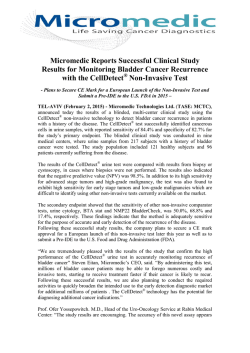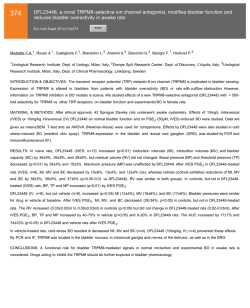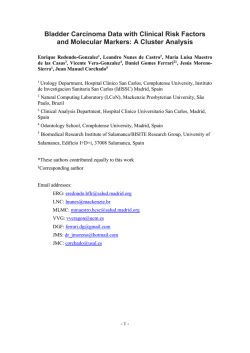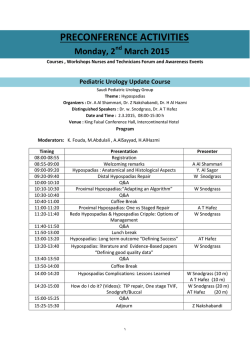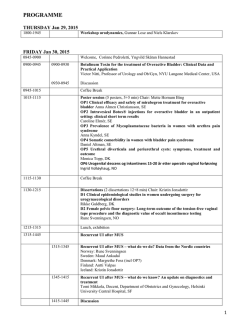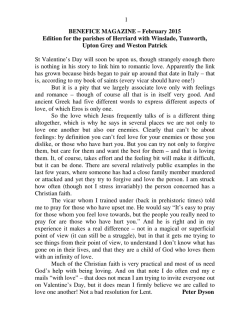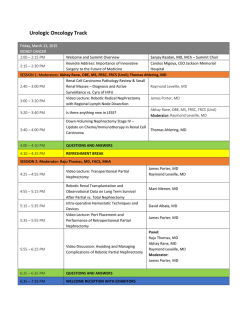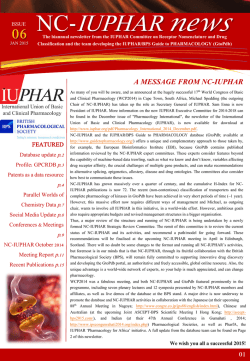
Basic Bladder Neurophysiology
Basic Bladder N e u ro p h y s i o l o g y J. Quentin Clemens, MD, MSCI KEYWORDS Normal lower urinary tract function requires the storage of urine at low intravesical pressure, without leakage. Intermittently, this storage function is interrupted by the voluntary and complete expulsion of urine. These processes (storage and voiding) are unique in that they involve the coordination of the peripheral autonomic, peripheral somatic, and central nervous systems (CNS). This article provides an overview of the basic principles that are recognized to regulate these functions, although many of these processes remain poorly understood. Furthermore, much of this knowledge has been obtained from in vivo animal models, and the relevance of these findings to human physiology is not always clear. low-pressure urine storage across a wide range of bladder volumes. This process is measured by calculating the bladder compliance (change in bladder volume/change in intravesical pressure), which is expressed in mL/cm H2O. Normal compliance is maintained throughout filling by reorientation of the detrusor smooth muscle fibers and connective tissue so that they are parallel to the lumen, thinning of the lamina propria, and flattening of the urothelium.4 Bladder accommodation is a complex and poorly understood process that can be altered because of neurologic damage or changes in the ECM content. For instance, an increase in type III collagen has been found in bladders with decreased compliance.5 BLADDER ANATOMY AND BIOMECHANICS GENERAL NEUROANATOMY The bladder base refers to the trigone and bladder neck, whereas the body consists of the supratrigonal portion.1 The bladder wall consists (from the outside, away from the bladder lumen) of the serosa, smooth muscle and extracellular matrix (ECM) (in approximately 50-50 distribution), the lamina propria, and the urothelium. Like other smooth muscles, the detrusor muscle is oriented in a seemingly random fashion, is not attached to tendon or bone, is able to maintain steady tension over a wide range of muscle lengths, and has a slower contraction velocity than the skeletal muscle.2,3 The detrusor muscle uses the ECM as a scaffold to generate tension, which produces a bladder contraction. Bladder accommodation refers to the changes that occur during bladder filling to permit The CNS consists of the brain and spinal cord, and the peripheral nervous system (PNS) consists of the sensory (afferent) and motor (efferent) neurons that communicate with the CNS. The PNS is divided into the somatic and the autonomic nervous systems. The somatic nervous system is responsible for regulating structures that are under conscious control (such as the striated external urethral sphincter and the levator muscles in the pelvic floor). The autonomic nervous system controls visceral and endocrine functions, including bladder contraction and relaxation. The autonomic nervous system is subdivided into the parasympathetic and sympathetic nervous systems. Sympathetic and parasympathetic are anatomic terms that indicate the location from where the nerve fibers emanate. Parasympathetic Disclosures: Merck, stock ownership; Pfizer, consultant, investigator; Lilly, consultant; Afferent Pharmaceuticals, consultant; Medtronic, proctor. Division of Neurourology and Pelvic Reconstructive Surgery, Department of Urology, University of Michigan Medical Center, 1500 East Medical Center Drive, Taubman Center 3875, Ann Arbor, MI 48109-5330, USA E-mail address: [email protected] Urol Clin N Am 37 (2010) 487–494 doi:10.1016/j.ucl.2010.06.006 0094-0143/10/$ e see front matter Ó 2010 Elsevier Inc. All rights reserved. urologic.theclinics.com Neuroanatomy Physiology Lower urinary tract Pharmacology 488 Clemens fibers emerge from the cranial and sacral segments of the spinal cord, whereas sympathetic fibers emerge from the thoracic and lumbar segments of the spinal cord. CROSS-SECTIONAL ANATOMY OF THE SPINAL CORD Peripheral sensory information is carried via afferent nerves fibers, which enter the dorsal (posterior) aspect of the spinal cord and then travel upward to the central processing centers in the CNS (Fig. 1). Afferent cell bodies are located in the dorsal root ganglia. The white matter of the spinal cord contains bundles of myelin-coated neurons, whereas the gray matter contains the cell bodies of interneurons and efferent motor neurons. Within the gray matter, nerve cell bodies are generally organized into functional clusters called nuclei (such as Onuf nucleus). Axons within the white matter are functionally grouped into tracts. Efferent motor axons exit from the ventral root of the spinal cord. RELEVANT NEUROANATOMY: PNS AND SPINAL CORD Preganglionic parasympathetic efferent nerves exit from the sacral segment of the spinal cord at S2 through S4. The axons travel a long distance within the pelvic nerve to the ganglia (pelvic plexus) that are located immediately adjacent to the end organ (bladder) (Fig. 2). These fibers modulate bladder contractions. The primary neurotransmitter for both pre- and postganglionic parasympathetic fibers is acetylcholine (ACh).6 DORSAL DRG Preganglionic sympathetic efferent nerves exit from the thoracolumbar segment of the spinal cord at T10 through L2. The ganglia for these nerves have variable locations: some are next to the vertebrae (paraganglia), some are between the vertebrae and the target organ (preganglia), and some are located with the end organ (peripheral ganglia).7 Sympathetic efferent nerves to the lower urinary tract are located within the hypogastric nerve. The sympathetic efferent nerves modulate contractions of the urethral smooth muscle and bladder outlet and inhibit parasympathetic activity that promotes bladder contraction. The primary neurotransmitter for postganglionic sympathetic fibers is norepinephrine, but the primary neurotransmitter for preganglionic sympathetic fibers is ACh. Preganglionic somatic efferent nerves exit from the sacral segment of the spinal cord at S2 through S4. Nerve bodies for these nerves are located in the Onuf nucleus, along the lateral border of the ventral gray matter in the sacral region of the spinal cord. The nerve fibers travel within the pudendal nerve to the external urethral sphincter, where they modulate striated (voluntary) sphincter contraction.8 In humans and animals, afferent nerves have been identified in the detrusor muscle and the suburothelium.9,10 The suburothelial afferent nerve fibers form a plexus that lies immediately beneath the urothelial lining, with some nerve terminals extending into the urothelium itself. This plexus is more prominent in the trigone and bladder neck and relatively sparse in the bladder dome. Afferent nerve fibers from the lower urinary tract travel within the pelvic, hypogastric, and pudendal DRG Sensory (Afferent) In GRAY MATTER WHITE MATTER VENTRAL Motor (Efferent) Out Fig. 1. Cross section of the sacral segment of the spinal cord. Sensory nerve fibers enter the dorsal spinal cord. Cell bodies of these sensory nerves are located in the dorsal root ganglia (DRG). The white matter contains bundles of neurons, whereas the gray matter contains the cell bodies of interneurons and efferent motor neurons. Motor nerve fibers exit the ventral spinal cord in the ventral root. Basic Bladder Neurophysiology Fig. 2. Parasympathetic efferent nerves exit from the sacral region of the spinal cord at S2 through S4 and travel within the pelvic nerve. Parasympathetic activity promotes bladder emptying by causing contraction of the detrusor and relaxation of the bladder outlet. Sympathetic efferent nerves exit from the thoracolumbar segment of the spinal cord at T10 through L2 and travel within the hypogastric nerve. These nerves modulate contractions of the urethral smooth muscle and bladder outlet and inhibit parasympathetic activity that promotes bladder contraction. Somatic efferent nerves exit from the sacral segment of the spinal cord at S2 through S4 and travel within the pudendal nerve to the external urethral sphincter, where they modulate striated (voluntary) sphincter contraction. Afferent nerve fibers from the lower urinary tract travel within the pelvic, hypogastric, and pudendal nerves. Therefore, these peripheral nerves carry bidirectional (afferent and efferent) information between the end organs and the spinal cord. nerves.11,12 Therefore, these peripheral nerves carry bidirectional (afferent and efferent) information between the end organs and the spinal cord. The sensory fibers enter the spinal cord via the dorsal root, and the nerve cells bodies are located within the dorsal root ganglia. Afferent nerves release numerous neurotransmitters (eg, substance P, neurokinins, calcitonin geneerelated polypeptide, vasoactive intestinal polypeptide).13 Most sensory innervation of the bladder and urethra originates in the thoracolumbar region of the spinal cord and travels within the pelvic nerve.12 Within the pelvic nerve, 2 types of bladder afferent nerves have been identified, myelinated Ad fibers and unmyelinated C fibers. The Ad fibers respond to normal bladder distention and are thought to be the primary functional afferent nerves during normal micturition.12 Conversely, the C fibers respond to chemical irritation (nociception) or to cold, and most of these fibers are inactive during normal micturition.14,15 However, during certain pathologic states (eg, inflammation, suprasacral spinal cord injury), these “silent” C fibers appear to activate, become mechanosensitive, and modulate pathologic voiding reflexes.16 RELEVANT NEUROANATOMY: BRAINSTEM AND ABOVE Conclusive experimental evidence using brainlesioning techniques, electric stimulation, and axonal tracing studies indicate that an area of the pons (the pontine micturition center [PMC] or Barrington nucleus) mediates the normal micturition reflex by coordinating the activity of the detrusor and urethral sphincter muscles.17e20 Therefore, spinal cord lesions below this level often result in discoordination between the detrusor and urethral sphincter (detrusor-sphincter dyssynergia). The PMC receives input from multiple higher brain centers, including the basal ganglia, periaqueductal gray, thalamus, and hypothalamus.21 Brain imaging studies in healthy volunteers suggest a model of supraspinal bladder control, in which afferent signals from the lower urinary tract are received in the periaqueductal gray and relayed 489 490 Clemens via the thalamus to the insula (which makes the sensations accessible to conscious awareness).22 According to this model, the cortex (via the anterior cingulate gyrus) monitors and controls micturition reflexes and also makes voluntary voiding decisions (via the prefrontal cortex). NEURAL CONTROL OF THE LOWER URINARY TRACT During the storage phase of micturition, bladder filling activates myelinated Ad afferent nerve fibers in the bladder wall. This afferent input results in stimulation of sympathetic efferent activity (via the hypogastric nerve), leading to contraction of smooth muscles in the bladder base and proximal urethra (via activation of a-adrenergic receptors) and relaxation of the detrusor (via activation of b-adrenergic receptors in the bladder body). Somatic efferent activity (via the pudendal nerve) also increases, resulting in increased tone of the striated external urethral sphincter. These responses occur by spinal reflex pathways organized in the lumbosacral region of the spinal cord and represent guarding reflexes, which promote continence.23e25 The parasympathetic system is largely inactive during urine storage, which may partly be because of the sympathetic inhibition of parasympathetic transmission at the ganglia level. The voiding phase of micturition is initiated voluntarily by signals from the cerebral cortex. The initial event is relaxation of the striated external urethral sphincter, caused by inhibition of somatic efferent activity. There is inhibition of sympathetic efferent activity, with concomitant activation of parasympathetic outflow to the bladder and urethra.26 Bladder contraction is mediated via muscarinic receptors in the bladder body, and urethral smooth muscle relaxation is mediated through the release of nitric oxide (NO).27 Maintenance of the voiding reflex is a complicated phenomenon that is mediated via communication between the spinal cord and the pons (spinobulbospinal reflex), with the involvement of midbrain structures such as the periaqueductal gray.21 PHARMACOLOGY OF THE LOWER URINARY TRACT Cholinergic Mechanisms In certain neurons of the CNS and PNS, the neurotransmitter ACh is synthesized from the essential nutrient choline by the enzyme choline acetyltransferase. In response to various stimuli, ACh is released into the synaptic cleft, where it either binds to cholinergic receptors or is broken down by acetylcholinesterase. ACh is released from postganglionic parasympathetic neurons, preganglionic autonomic neurons (sympathetic and parasympathetic), and somatic neurons. Two main types of cholinergic receptors exist: nicotinic and muscarinic. Nicotinic receptors (which are responsive to ACh and nicotine) are ligand-gated ion channels and are found on the skeletal muscle motor end plates, on the autonomic ganglia, and in the CNS. The nicotinic receptors seem to have a limited role in the control of micturition. Muscarinic receptors (which are responsive to ACh and muscarine) are G proteinecoupled receptors that activate ion channels via second-messenger cascades. These receptors are found on all autonomic effector cells (eg, bladder, sweat glands, bowel) and in the CNS. Five subtypes of muscarinic receptors (M1 through M5) have been identified, and the M2 and M3 subtypes predominate in the bladder.28 Although M2 receptors are the most plentiful in the detrusor (70% M2 vs 30% M3 receptors), in vitro studies indicate that the M3 receptors are responsible for detrusor muscle contraction.29e32 The functions of the detrusor M2 receptors are less clear. Muscarinic receptors are also found on presynaptic nerve terminals in the bladder and elsewhere, where they may play a regulatory role via feedback inhibition.33,34 Excitation-contraction Coupling Excitation-contraction coupling refers to the process whereby binding of a ligand to a receptor causes force generation (muscle contraction) (Fig. 3).35 In the detrusor smooth muscle, the ligand is ACh and the receptor is the M3 receptor. At rest, there is a very low concentration of free calcium ions (Ca21) in the smooth muscle cell. Binding of ACh to the M3 receptor triggers a G proteinemediated process, which causes Ca21 release from the sarcoplasmic reticulum as well as Ca21 influx from transmembrane ion channels. The free Ca21 binds to calmodulin, and the Ca21-calmodulin complex then activates the enzyme myosin light chain kinase, which phosphorylates the light chain of the contractile protein, myosin. This phosphorylation causes the myosin light chain to change shape and interact with actin, causing force generation.35 Alongside this process, alternate methods are at work to facilitate subsequent muscle relaxation. The Ca21-calmodulin complex activates transmembrane Ca21 pumps to remove free Ca21 from the cell, the ligand-receptor complex is degraded, and excess extracellular ACh is degraded by acetylcholinesterase. This enzyme is abundant in the synaptic cleft, and its role in rapidly clearing free ACh Basic Bladder Neurophysiology Nerve Terminal ACh ACh ACh ACh ACh ACh ACh Ca2+ ACh G Protein M3 ACh PLC IP3 Ca2+ CONTRACTION SR Actin Ca2+ MLCK Ca2+ My osin Calmodulin Fig. 3. Excitation-contraction coupling. Ach is released from postganglionic parasympathetic nerve terminals into the synaptic cleft, where it binds to the M3 receptor. This ligand-receptor complex triggers a cascade of signaling events that involves a G protein, phospholipase C (PLC), and inositol triphosphate (IP3). This signaling cascade leads to the release of free calcium (Ca21) into the cytosol by the sarcoplasmic reticulum (SR) as well as a direct influx of Ca21 via transmembrane ion channels. The free Ca21 binds with calmodulin, and the resulting Ca21-calmodulin complex activates the enzyme myosin light chain kinase (MLCK). The MLCK causes changes in the structure of the myosin molecule, which allows the myosin to interact with actin, leading to a muscle contraction. from the synapse is essential for proper muscle function. where they cause detrusor smooth muscle relaxation.38 Adrenergic Mechanisms Receptor Distribution in the Lower Urinary Tract Adrenergic receptors are G proteinecoupled receptors that bind catecholamines (most commonly norepinephrine and epinephrine) that are released from postganglionic sympathetic neurons. Stimulation of a-adrenergic receptors causes vasoconstriction and smooth muscle contraction, whereas stimulation of b-adrenergic receptors causes increased myocardial contractility and smooth muscle relaxation. There exists multiple subtypes of adrenergic receptors. a-Adrenergic receptors were initially divided into a1 (postsynaptic) and a2 (presynaptic) receptors, but a2 receptors were subsequently also found in postsynaptic locations. There are 3 subtypes of a1 receptors (a1A, a1B, and a1D). The a1A subtype is the primary subtype in the prostate and urethra, where it mediates contraction of the bladder outlet.36,37 The role of a2 receptors in the lower urinary tract is not clear. There are 3 subtypes of b-adrenergic receptors (b1, b2, and b3). b1 Receptors are located in the heart, whereas b2 and b3 receptors are located in the lower urinary tract, The actions of the various neurotransmitters on the lower urinary tract are largely a function of receptor location.39,40 There is a higher density of muscarinic receptors in the bladder body than in the base, and therefore activation of these receptors results in detrusor contraction. Adrenergic receptors are distributed such that a-adrenergic receptors (muscle contraction) predominate in the bladder base and urethra, whereas b-adrenergic receptors (muscle relaxation) predominate in the bladder body. Therefore, activation of the sympathetic nervous system promotes urine storage (relaxation of the bladder body and contraction of the outlet). Nonadrenergic Noncholinergic Mechanisms of Bladder Excitation In various mammalian species, complete blockage of cholinergic receptors with atropine does not pre-vent detrusor muscle contraction,27 indicating that nonadrenergic noncholinergic (NANC) 491 492 Clemens mechanisms exist, which at least partially mediate bladder contractions. In these nonhuman mammals, there is good evidence that the transmitter responsible for the NANC component of detrusor contraction is adenosine triphosphate (ATP) acting on purinergic receptors.41,42 However, the component of NANC activation in the normal human detrusor seems to be small. It is possible, however, that NANC mechanisms may become more predominant in certain pathologic states (eg, bladder outlet obstruction, overactive bladder, neurogenic bladder, interstitial cystitis).43,44 Nitric Oxide Stimulation of cholinergic receptors in the urethra causes contraction, rather than relaxation, of the urethral smooth muscle.45 Therefore, parasympathetic pathways that promote voiding must elicit urethral relaxation via noncholinergic mechanisms. Experimental studies indicate that NO, released from postganglionic parasympathetic nerves, is the major inhibitory neurotransmitter that causes the urethral smooth muscle relaxation during voiding.46,47 The mechanism of relaxation is similar to that observed in corporal smooth muscle (increased production of intracellular cyclic guanosine monophosphate and so forth). The functional role of NO in the detrusor has not been established. Vanilloids Vanilloids are a class of compounds denoted by the presence of a vanillyl functional group. Two vanilloids (capsaicin and resiniferatoxin [RTX]) are known to bind to receptors on C-fiber afferent neurons. This binding causes desensitization, so that the neurons no longer respond to stimuli. As discussed previously, C-fiber afferent neurons are considered to mediate pathologic bladder reflexes. Therefore, intravesical treatment with capsaicin and RTX has been examined as a potential therapy for conditions such as neurogenic detrusor overactivity and interstitial cystitis.48,49 Additional Neurotransmitters and Receptors Multiple additional neurotransmitters and their associated receptors have been found to be synthesized, stored, and released in the human lower urinary tract, including tachykinins (eg, substance P, neurokinins), prostanoids (prostaglandins and thromboxanes), and endothelins.13,35 However, the functional roles of most of these agents have not been established, and animal experiments suggest that these roles may vary across species. SENSORY ROLE OF THE UROTHELIUM The urothelium has traditionally been viewed as a passive barrier that prevents passage of urinary toxins into the underlying bladder interstitium. However, there is increasing evidence that the urothelium also has sensory and signaling properties that allow it communicate with nearby nerve and muscle tissue, suggesting that it is actively involved in the storage and voiding phases of micturition.50,51 For instance, the urothelium has been shown to release chemical mediators (ATP, ACh, and NO) and to express numerous receptors (eg, muscarinic, adrenergic, purinergic, and tachykinin receptors).35,52 The mechanisms responsible for urothelial ATP release have been the subject of considerable study because intravesical administration of ATP induces detrusor overactivity and mice deficient in the ATP receptor P2X3 exhibit decreased voiding frequency and increased bladder capacity.53,54 Therefore, further understanding of these findings may provide additional therapeutic targets for lower urinary tract disorders. REFERENCES 1. Elbadawi A, Schenk EA. Dual innervation of the mammalian urinary bladder, a histochemical study of the distributions of cholinergic and adrenergic nerves. Am J Anat 1966;119:405e27. 2. Uvelius B. Length-tension relations of in vitro urinary bladder smooth muscle strips. J Pharmacol Toxicol Methods 2001;45:87e90. 3. Uvelius B, Gabella G. Relation between cell length and force production in urinary bladder smooth muscle. Acta Physiol Scand 1980;110:357e65. 4. Chang SL, Chung JS, Yeung MK, et al. Roles of the lamina propria and the detrusor in tension transfer during bladder filling. Scand J Urol Nephrol Suppl 1999;201:38e45. 5. Landau EH, Jayanthi VR, Churchill BM, et al. Loss of elasticity in dysfunctional bladders: urodynamic and histochemical correlation. J Urol 1994;152:702e5. 6. de Groat WC, Booth AM. Synaptic transmission in pelvic ganglia. In: Maggi CA, editor. Nervous control of the urogenital system: the autonomic nervous system, vol. 3. London: Harwood Academic; 1993. p. 291e347. 7. Kihara K, de Groat WC. Sympathetic efferent pathways projecting to the bladder neck and proximal urethra in the rat. J Auton Nerv Syst 1997;62: 134e42. 8. Thor KB, Morgan C, Nadelhaft I, et al. Organization of afferent and efferent pathways in the pudendal nerve of the female cat. J Comp Neurol 1989;288: 263e79. Basic Bladder Neurophysiology 9. Dixon JS, Gilpin CJ. Presumptive sensory axons of the human urinary bladder: a fine structural study. J Anat 1987;151:199e207. 10. Gabella G, Davis C. Distribution of afferent axons in the bladder of rats. J Neurocytol 1998;27:141e55. 11. Yoshimura N, de Groat WC. Neural control of the lower urinary tract. Int J Urol 1997;4:111e25. 12. Janig W, Morrison JFB. Functional properties of spinal visceral afferents supplying abdominal and pelvic organs, with special emphasis on visceral nociception. Prog Brain Res 1986;67:87e114. 13. Andersson KE. Bladder activation: afferent mechanisms. Urology 2002;59(Suppl 5A):43e50. 14. Habler HJ, Janig W, Koltzenburg M. Activation of unmyelinated afferent fibres by mechanical stimuli and inflammation of the urinary bladder in the cat. J Physiol 1990;425:545e62. 15. Fall M, Lindstrom S, Mazieres L. A bladder-tobladder cooling reflex in the cat. J Physiol 1990; 427:281e300. 16. de Groat WC, Kawatani M, Hisamitsu T, et al. Mechanisms underlying the recovery of urinary bladder function following spinal cord injury. J Auton Nerv Syst 1990;30:S71e7. 17. Barrington FJ. The effects of lesions of the hind and midbrain on micturition in the cat. Q J Exp Physiol 1925;15:81e102. 18. Mallory BS, Roppolo JR, de Groat WC. Pharmacologic modulation of the pontine micturition center. Brain Res 1991;546:310e20. 19. Holstege G, Griffiths D, De Wall H, et al. Anatomical and physiological observations on supraspinal control of the bladder and urethral sphincter muscles in the cat. J Comp Neurol 1986;250: 449e61. 20. Nadelhaft I, Vera PL, Card JP, et al. Central nervous system neurons labeled following the injection of pseudorabies virus into the rat urinary bladder. Neurosci Lett 1992;143:271e4. 21. Fowler CJ, Griffiths G, de Groat WC. The neural control of micturition. Nat Rev Neurosci 2008;9: 453e66. 22. Griffiths D, Tadic SD. Bladder control, urgency, and urge incontinence: evidence from functional brain imaging. Neurourol Urodyn 2008;27:466e74. 23. de Groat WC, Booth AM, Yoshimura N. Neurophysiology of micturition and its modification in animal models of human disease. In: Maggi CA, editor. Nervous control of the urogenital system: the autonomic nervous system, vol. 3. London: Harwood Acadmeic Publishers; 1993. p. 227. 24. de Groat WC, Vizzard MA, Araki I, et al. Spinal interneurons and preganglionic neurons in sacral autonomic reflex pathways. Prog Brain Res 1996;107: 97e111. 25. Park JM, Bloom DA, McGuire EJ. The guarding reflex revisited. Br J Urol 1997;80:940e5. 26. de Groat WC. Organization of the sacral parasympathetic reflex pathways to the urinary bladder and large intestine. J Auton Nerv Syst 1981;3:135e60. 27. Andersson KE. Pharmacology of lower urinary tract smooth muscles and penile erectile tissues. Pharmacol Rev 1993;45:253e308. 28. Bschleipfer T, Schukowski K, Weidner W, et al. Expression and distribution of cholinergic receptors in the human urothelium. Life Sci 2007;80:2303e7. 29. Harriss DR, Marsh KA, Birmingham AT, et al. Expression of muscarinic M3 receptors coupled to inositol phospholipid hydrolysis in human detrusor smooth muscle cells. J Urol 1995;154:1241e5. 30. Yamaguchi O, Shishido K, Tamura K, et al. Evaluation of mRNAs encoding muscarinic receptor subtypes in human detrusor muscle. J Urol 1996;156:1208e13. 31. Hegde SS, Choppin A, Bonhaus D, et al. Functional role of M2 and M3 muscarinic receptors in the urinary bladder of rats in vitro and in vivo. Br J Pharmacol 1997;120:1409e18. 32. Lai FM, Cobuzzi A, Spinelli W. Characterization of muscarinic receptors mediating the contraction of the urinary detrusor muscle in cynomolgus monkeys and guinea pigs. Life Sci 1998;62:1179e86. 33. D’Agostino G, Bolognesi ML, Lucchelli A, et al. Prejunctional muscarinic inhibitory control of acetylcholine release in the human isolated detrusor: involvement of the M4 receptor subtype. Br J Pharmacol 2000;129:493e500. 34. Somogyi GT, de Groat WC. Evidence for inhibitory nicotinic and facilitatory muscarinic receptors in cholinergic nerve terminals of the rat urinary bladder. J Auton Nerv Syst 1992;37:89e97. 35. Andersson KE, Arner A. Urinary bladder contraction and relaxation: physiology and pathophysiology. Physiol Rev 2004;84:935e86. 36. Furuya S, Kumamoto Y, Yokoyama E, et al. Alphaadrenergic activity and urethral pressure in prostatic zone in benign prostatic hypertrophy. J Urol 1982; 128:836e9. 37. Nasu K, Moriyama N, Fukasawa R, et al. Quantification and distribution of alpha-1 adrenoreceptor subtype mRNAs in human proximal urethra. Br J Pharmacol 1998;123:1289e93. 38. Yamaguchi O. Beta 3-adrenoceptors in human detrusor muscle. Urology 2002;59(Suppl 1):25e9. 39. Johns A. Alpha- and beta-adrenergic and muscarinic cholinergic binding sites in the bladder and urethra of the rabbit. Can J Physiol Pharmacol 1983;61:61e6. 40. Levin RM, Ruggieri MR, Wein AJ. Identification of receptor subtypes in the rabbit and human urinary bladder by selective radio-ligand binding. J Urol 1988;139:844e8. 41. Lee HY, Bardini M, Burnstock G. Distribution of P2X receptors in the urinary bladder and the ureter of the rat. J Urol 2000;163:2002e7. 493 494 Clemens 42. O’Reilly BA, Kosaka AH, Chang TK, et al. A quantitative analysis of purinoceptor expression in human fetal and adult bladders. J Urol 2001; 165:1730e4. 43. Bayliss M, Wu C, Newgreen D, et al. A quantitative study of atropine-resistant contractile responses in human detrusor smooth muscle from stable, unstable and obstructed bladders. J Urol 1999;162:1833e9. 44. Palea S, Artibani W, Ostardo E, et al. Evidence for purinergic neurotransmission in human urinary bladder affected by interstitial cystitis. J Urol 1993; 150:2007e12. 45. Ek A. Innervation and receptor functions of the human urethra. Scand J Urol Nephrol Suppl 1977; 45:1e50. 46. Andersson KE, Garcia Pascual A, Persson K, et al. Electrically-induced, nerve-mediated relaxation of rabbit urethra involves nitric oxide. J Urol 1992; 147:253e9. 47. Bennett BC, Kruse MN, Roppolo JR, et al. Neural control of urethral outlet activity in vivo: role of nitric oxide. J Urol 1995;153:2004e9. 48. Fowler CJ, Beck R, Gerrard S, et al. Intravesical capsaicin for treatment of detrusor hyperreflexia. J Neurol Neurosurg Psychiatry 1994;57: 169e73. 49. Payne CK, Mosbaugh PG, Forrest JB, et al. Intravesical resiniferatoxin for the treatment of interstitial cystitis: a randomized, double-blind, placebo controlled trial. J Urol 2005;173:1590e4. 50. Apodaca G. The uroepithelium: not just a passive barrier. Traffic 2004;5:117e28. 51. Ferguson DR. Urothelial function. BJU Int 1999;84: 235e42. 52. Birder LA, de Groat WC. Mechanisms of disease involvement of the urothelium in bladder dysfunction. Nat Clin Pract Urol 2007;4:46e54. 53. Pandita RK, Andersson KE. Intravesical ATP stimulates the micturition reflex in awake, freely moving rats. J Urol 2002;168:1230e4. 54. Cockayne DA, Hamilton SG, Zhu QM, et al. Urinary bladder hyporeflexia and reduced pain-related behaviour in P2X3-deficient mice. Nature 2000; 407:1011e5.
© Copyright 2026
